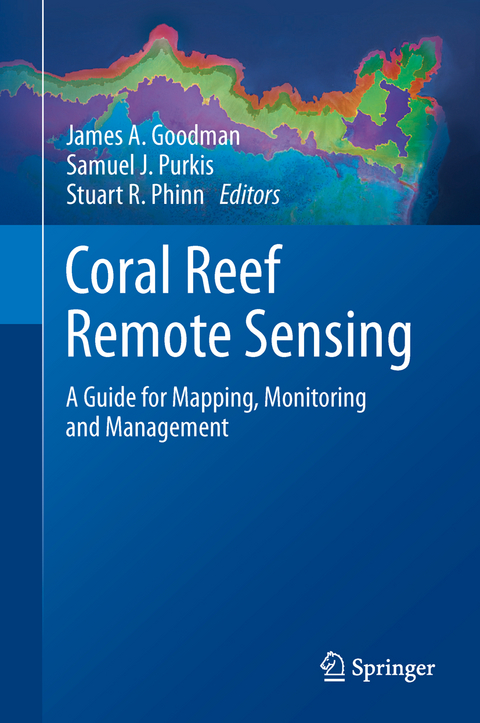Coral Reef Remote Sensing
Remote sensing is now a fundamental tool for the mapping, monitoring and management of coral reef ecosystems. Remote sensing offers repeatable, quantitative assessments of habitat and environmental characteristics over spatially extensive areas. As the multi-disciplinary field of coral reef remote sensing continues to mature, results demonstrate that the techniques and capabilities continue to improve. New developments allow reef assessments and mapping to be performed with higher accuracy, across greater spatial areas, and with greater temporal frequency. The increased level of information that remote sensing now makes available also allows more complex scientific questions to be addressed.
As defined for this book, remote sensing includes the vast array of geospatial data collected from land, water, ship, airborne and satellite platforms. The book is organized by technology, including: visible and infrared sensing using photographic, multispectral and hyperspectral instruments; active sensing using light detection and ranging (LiDAR); acoustic sensing using ship, autonomous underwater vehicle (AUV) and in-water platforms; and thermal and radar instruments.
Emphasis and Audience
This book serves multiple roles. It offers an overview of the current state-of-the-art technologies for reef mapping, provides detailed technical information for coral reef remote sensing specialists,imparts insight on the scientific questions that can be tackled using this technology, and also includes a foundation for those new to reef remote sensing. The individual sections of the book include introductory overviews of four main types of remotely sensed data used to study coral reefs, followed by specific examples demonstrating practical applications of the different technologies being discussed. Guidelines for selecting the most appropriate sensor for particular applications are provided, including an overview of how to utilize remote sensing data as an effective tool in science and management. The text is richly illustrated with examples of each sensing technology applied to a range of scientific, monitoring and management questions in reefs around the world. As such, the book is broadly accessible to a general audience, as well as students, managers, remote sensing specialists and anyone else working with coral reef ecosystems.
Section I Visible and Infrared 1 Visible and Infrared Overview 1.1 Introduction 1.2 Physical and Technical Principles 1.3 Image Processing 1.4 Future Directions Suggested Reading References 2 Photography Applications 2.1 Introduction 2.2 Photography of Coral Reefs 2.3 Photography Analysis and Classification Techniques 2.4 Example Applications of Photography 2.5 Conclusions and Future Directions Suggested Reading References 3 Multispectral Applications 3.1 Introduction 3.2 Multispectral Analysis and Classification 3.3 Example Applications 3.4 Conclusions and Future Directions Suggested Reading References 4 Hyperspectral Applications 4.1 Introduction 4.2 Hyperspectral Planning and Preprocessing 4.3 Hyperspectral Algorithms 4.4 Conclusions Suggested Reading References Section II LiDAR 5 LiDAR Overview 5.1 Introduction 5.2 Physical Principles 5.3 Image Products and Environmental Variables 5.4 Processing and Validation Requirements Suggested Reading References 6 LiDAR Applications 6.1 Introduction 6.2 Example LiDAR Applications 6.3 Future Directions in LiDAR 6.4 Conclusion Suggested Reading References 7 Integrated LiDAR and Hyperspectral 7.1 Introduction 7.2 LiDAR/Hyperspectral Processing 7.3 Applications of LiDAR/Hyperspectral Fusion 7.4 Summary and Discussion Suggested Reading References Section III Acoustic 8 Acoustic Methods Overview 8.1 Introduction 8.2 Physical and Technical Principles 8.3 Applications of Acoustics 8.4 Conclusion Suggested Reading References 9 Acoustic Applications 9.1 Introduction 9.2 Applications 9.3 State of the Science and Future Directions Suggested Reading References 10 Deep Acoustic Applications 10.1 Introduction 10.2 History of Mapping Cold-Water Coral Habitats 10.3 Cold-Water Coral Mapping Example 10.4 Conclusions and Recommendations Suggested Reading References Section IV Thermal and Radar 11 Thermal and Radar Overview 11.1 Introduction 11.2 Thermal Overview 11.3 Radar Overview 11.4 Conclusion Suggested Reading References 12 Thermal Applications 12.1 Introduction 12.2 Thermal Data Products and Analysis 12.3 Example Thermal Applications 12.4 Future Directions Suggested ReadingReferences 13 Radar Applications 13.1 Introduction 13.2 HF Ocean Radar 13.3 VHF High Resolution Radar 13.4 Synthetic Aperture Radar 13.5 Scatterometers 13.6 X-band Wave Radars 13.7 Conclusions and Future Directions Suggested Reading References Section V Effective Use of Remote Sensing in Science and Management 14 Validation 14.1 Introduction 14.2 Sampling Design and Accuracy Measures 14.3 Validation Literature Review 14.4 Conclusions and Recommendations Suggested Reading References 15 Science and Management 15.1 Introduction 15.2 Research and Management Needs 15.3 Example Applications 15.4 Conclusions and Recommendations Suggested Reading References Index
From the Foreword:"This remarkable book, Coral Reef Remote Sensing: A Guide for Mapping, Monitoring and Management, for the first time documents the full range of remote sensing systems, methodologies and measurement capabilities essential to understanding more fully the status and changes over time of coral reefs globally. Such information is essential and provides the foundation for policy development and for implementing management strategies to protect these critically endangered ecosystems. ... Included here is an overview of technologies for reef mapping, technical information useful for scientists and other research and policy development experts, ideas for application of remote sensing to resolve questions, and thoughts about future remote sensing technologies and their applications. I wholeheartedly recommend this book to scientists, students, managers, remote sensing specialists and anyone who would like to be inspired by the ingenious new ways that have been developed and are being applied to solve one of the world’s greatest challenges: how to take care of the ocean that takes care of us."Sylvia A. EarleNational Geographic Explorer in ResidenceFounder, Mission Blue
| Erscheint lt. Verlag | 8.7.2013 |
|---|---|
| Zusatzinfo | 110 Illustrations, color; 36 Illustrations, black and white; XXV, 436 p. 146 illus., 110 illus. in color. |
| Verlagsort | Dordrecht |
| Sprache | englisch |
| Maße | 155 x 235 mm |
| Themenwelt | Naturwissenschaften ► Biologie ► Ökologie / Naturschutz |
| Naturwissenschaften ► Geowissenschaften ► Geografie / Kartografie | |
| Naturwissenschaften ► Geowissenschaften ► Geologie | |
| Naturwissenschaften ► Geowissenschaften ► Meteorologie / Klimatologie | |
| Technik ► Umwelttechnik / Biotechnologie | |
| ISBN-10 | 90-481-9291-9 / 9048192919 |
| ISBN-13 | 978-90-481-9291-5 / 9789048192915 |
| Zustand | Neuware |
| Haben Sie eine Frage zum Produkt? |
aus dem Bereich




